History of Amboni Cave
The name Amboni originated from Mama Mboni. At the current locality, there had a mother called Mama Mboni who had very big land. When European colonialists came, they needed a large area of land from Mama
Mboni for conducting sisal plantations. So, they failed to pronounce Mama Mboni instead they pronounced Mama Amboni. According to geologists and researchers, the caves have been there for about 150 million since the Jurassic era. In all hundred and fifty million years, for about twenty million years the caves have been underwater to mean under the Indian Ocean. Amboni caves are the biggest limestone caves in East Africa. But also, they are the second largest limestone caves in
the world.
The caves have been used for a long time by Tanga indigenous people among the tribes such as Zigua, Bondei, Digo, and Sambaa who have been using the caves for ages
Inside The Amboni Cave
There are about 13 stations inside Amboni cave. The cave has many wonders that one can learn through visiting this attraction. The attractions
include,
Natural Made Features
These are the main attraction of the Amboni Caves. Inside the cave, there are various features or figures, according to geologists and researchers argue that those features and figures have been made by ocean water as a result of eroding weak limestone parts.
Rocky Drawing
Some rocks are drawn in various shapes of resting chairs, a ship, a crocodile, Mount Kilimanjaro, an elephant, a map of Africa, and the head of a male lion. They are the leading attraction for people coming to Amboni, as they serve for both Historical explorations and tourism.
Dancing place
There is a dancing or picnic place which is the biggest open space. In the same place, there is a small chamber that looks like DJ’s room. The place seems to be where the indigenous people used to dance to their traditional songs and beat drums.
Bat colonies
Many bats are living in the cave. They have made a leopard-like feature but also, they have made a footstep feature. Every evening at sunset they are observed flying out of the cave through the entrance. In addition to that, watching bat flights is a very interesting adventure while at Amboni.
Generally, Tanga has a lot of tourist destinations. This place has unique attractions that tourists regularly pay to visit apart from Amboni Caves.
There are so many other places such as camping places, mountains to hike on, and waterfalls at Pangani River.
Additionally, Tanzania is a safe country with peace and harmony in every region around the country. Tanzanians are friendly and everyone is welcome. Tanga, in particular, is the one region where everybody believes one cannot pay a visit and leave as they had planned, they usually overstay because of the hospitality of the people.
cultural Beliefs
The Amboni caves are one of the most popular tourist attractions in the area and feature extensive underground halls with formations that are
towering. Tourists are encouraged to put on comfortable footwear and carry with them pocket-size cameras as it is exhausting to carry cameras with big lenses while moving through tight squeezes. Tourists are also requested to leave big bags at a designated spot before entering some tight spots. However, the breathtaking formation seen while walking through the squeezes make the trip worthwhile. To the local communities, the Amboni caves hold a religious meaning as
they are used as shrines for prayers and making sacrifices. To some locals, the caves have been a place to pray for various needs since ancient times.
The first chamber is utilized for prayers in what most people regard as superstitious. Various items are put in the chamber by the villagers during prayers as gifts offered to the spirits. The maintenance of the caves is done by the Department of Antiquities in the ministry of natural resources and tourism.
Underground lakes and rivers
The Amboni Caves also contain several underground lakes and rivers, which are fed by the surrounding groundwater. These bodies of water are home to various aquatic creatures, such as fish and crabs. Amboni caves is the home for several stunning species of bats.
Location of Amboni Caves
The Amboni caves are situated approximately eight kilometres from Tanga and are accessed by the road branching from the Tanga- Mombasa
highway. In order to access the main forest section (Msitu wa Mbogo), after leaving Tanga, take a left turn onto the B121 road leading to Mjessani. Park your vehicle about 5.5 kilometres along the B121 road and take a footpath South for two kilometres until you arrive at the river. In order to access Amboni forest patches, turn left four kilometres after exiting Tanga on the Tanga- Mombasa Road to Kimono village. The road passes throughout the village and leads to the caves further down. Park the vehicle and walk along the river to find the other forest patches upstream. All these sites can be accessed on foot from Tanga within 2 hours.



